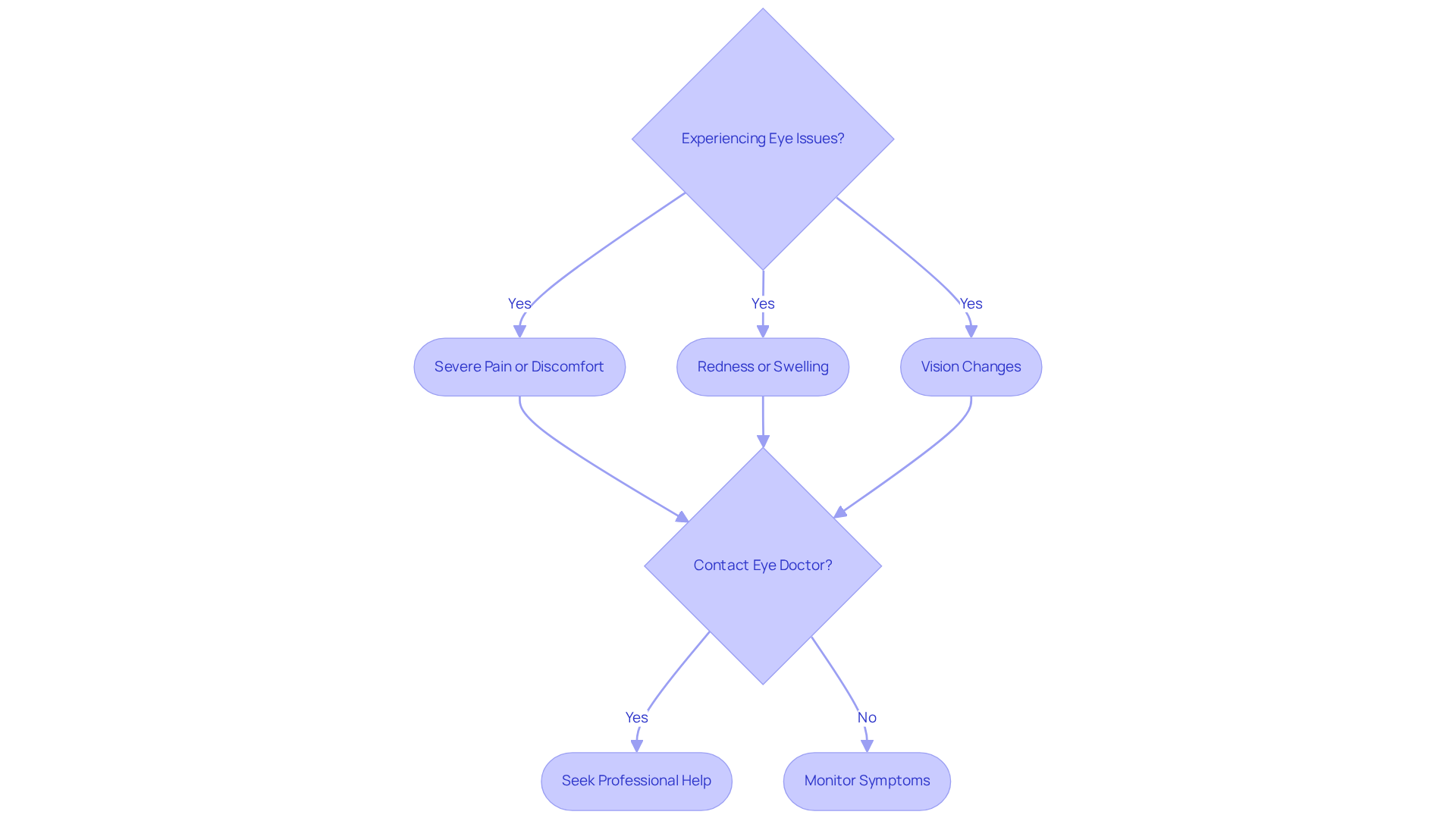Posted by: Northwest Eye in General on November 23, 2025
Introduction
Losing a contact lens in your eye can be a truly alarming and disorienting experience. We understand that this moment can feel overwhelming, and knowing what steps to take is crucial. Remaining calm can significantly influence the outcome, and that’s why we’re here to help you through this process.
This guide provides a detailed roadmap for retrieving a lost lens, equipping you with effective techniques and insights to navigate this common yet distressing situation. It’s common to feel anxious, but rest assured, you’re not alone in this.
But what if these methods don’t yield results? Knowing when to seek professional help could make all the difference in safeguarding your eye health. Remember, your well-being is our priority, and we’re here to support you every step of the way.
Stay Calm: Initial Steps to Take
If you find yourself in the situation of having a contact lost in eye, the first and most crucial step is to take a deep breath and remain calm. We understand that this can be a distressing experience, but panic can lead to erratic movements that may exacerbate the issue. Remember, contact optics are designed with safety in mind and ensure that contact lost in eye cannot occur due to the conjunctiva’s structure, which creates a pocket that prevents objects from going behind the eye.
It’s common to feel anxious, but rubbing your eye should be avoided, as this can lead to irritation or potential harm. Instead, take a moment to assess your feelings and prepare to follow the next steps with care. Eye care professionals emphasize that staying calm is crucial; as Dr. Inna Lazar notes, maintaining composure can significantly impact the outcome of the situation. Real-life experiences from patients demonstrate that those who handle the situation calmly are more likely to successfully find and recover their eyewear when contact lost in eye occurs.
If you notice blurred vision during this process, it may suggest that the optical element has shifted from its position or that there are underlying concerns such as dry eyes or other refractive issues. To assist in locating the contact, consider using artificial tears to enable it to move more freely. You might try the ‘slide and seek’ method by closing your eye and feeling over the lid for any bumps or ripples that could indicate the contact’s position.
Furthermore, check your vision by covering the other eye; if your vision is blurry or distorted, it may signal a need for professional evaluation. By prioritizing calmness and following these steps, you not only enhance your chances of resolving the issue but also contribute to a more positive overall experience in eye care. We are here to help you through this process.

Locate the Lens: Step-by-Step Retrieval Process
-
Wash Your Hands: We understand that keeping things clean is important to you. Start by thoroughly washing your hands with soap and water for at least 20 seconds. This simple step can significantly reduce the risk of infections, especially when there is a contact lost in eye while handling items. Once you’re done, dry your hands with a clean towel. Your health matters, and proper hand hygiene is a key part of that.
-
Use a Mirror: It’s common to feel a bit anxious about this process. Find a well-lit mirror that allows you to see your eye clearly. This will help you locate the optical component more easily.
-
Gently Pull Your Eyelids: Look up and gently pull down your lower eyelid while lifting your upper eyelid. This technique will give you a better view of your eye’s surface, especially if you experience contact lost in eye, making it easier to manage.
-
Blink and Look Around: Take a moment to blink a few times. This can help shift the optical element into a more accessible position. If you look in the opposite direction of where you think the optical device is, it might just come into view.
-
Use Eye Drops: If you still can’t see the contact, don’t worry! Applying a few drops of saline solution or rewetting drops can help smooth the optical element, making it simpler to find. Remember, we are here to help you through this process.

Troubleshoot: What to Do If You Encounter Problems
If you’re having trouble locating or removing your lens, we understand how concerning that can be. Here are some helpful tips to guide you:
-
Lens Stuck Under Eyelid: If you feel like the lens is stuck under your eyelid, gently massage the eyelid in a circular motion. This can help shift the lens into a more accessible position, making it easier for you to remove.
-
Dryness: It’s common to experience dryness in your eyes. If that’s the case, applying more rewetting drops can really help. This will moisturize the surface of your eye and assist the lens in regaining its form, facilitating removal.
-
Ongoing Discomfort: If you’re experiencing significant discomfort or irritation, possibly due to allergies, conjunctivitis, dry eye disease, or keratoconus, it’s best to stop trying to remove the contact lens. We encourage you to seek professional assistance right away. Symptoms like sore, red, or itchy eyes shouldn’t be ignored, as they may indicate underlying issues that require evaluation and advanced treatment options at Northwest Eye.
Remember, we are here to help you through this process, and your comfort and safety are our top priorities.

Seek Professional Help: When to Contact Your Eye Doctor
If you’ve followed the earlier steps and still can’t find or remove the eye piece, it’s important to seek expert help. We understand that this can be a stressful situation, so please contact your eye doctor if you notice any of these signs:
- Severe Pain or Discomfort: If you’re experiencing sharp pain or ongoing discomfort in your eye, it’s a strong signal that you need immediate attention.
- Redness or Swelling: Noticeable redness or swelling around your eye could indicate irritation or an infection, which requires prompt evaluation.
- Vision Changes: Blurred vision or any unusual visual symptoms, like contact lost in eye, shouldn’t be ignored, as they can point to complications that need to be addressed.
It’s common for wearers of optical devices to encounter issues, with one-third reporting at least one healthcare visit for a red or painful eye while using them. In severe cases, some individuals have been found with multiple pairs of eye inserts still in their eyes, resulting in significant health risks from contact lost in eye. Ophthalmologists stress the importance of recognizing these signs early. As Hugh R. Parry, president and CEO of Prevent Blindness, advises, “We urge anyone who is interested in using corrective eyewear to consult an eye care specialist first.” Additionally, Drew Dickson, MD, warns, “If you depend on corrective eyewear to see, you might be at a higher risk than you understand.” Your eye doctor has the right tools and expertise to safely remove the lens and manage any potential complications effectively. Remember, we are here to help you through this process.

Conclusion
Staying calm and following a structured approach is essential when dealing with a lost contact lens in the eye. We understand that this can be a stressful situation, and taking a deep breath can help ease your mind. Remember, panic can hinder recovery. By following these steps – washing your hands, using a mirror, and applying eye drops – you can enhance your chances of successfully locating and retrieving the lens without causing further irritation.
Key strategies include:
- Gently manipulating your eyelids to get a clearer view.
- Utilizing artificial tears for easier movement of the lens.
- Recognizing when to seek professional help.
If you experience severe pain, redness, or changes in vision, it’s important to consult with an eye care specialist right away. Proper techniques not only aid in retrieval but also ensure the health and safety of your eyes.
Ultimately, being informed and prepared can significantly reduce anxiety during such unsettling situations. By understanding the steps to take and when to seek assistance, you can navigate the challenge of a lost contact lens with confidence and care. Prioritizing your eye health is paramount, and knowing when to reach out for professional support can make all the difference in maintaining optimal vision and comfort. We are here to help you through this process.
Frequently Asked Questions
What should I do first if I lose a contact lens in my eye?
The first step is to take a deep breath and remain calm. Staying calm is crucial as panic can lead to erratic movements that may worsen the situation.
Is it safe for a contact lens to get lost in the eye?
Yes, contact lenses are designed with safety in mind. The structure of the conjunctiva creates a pocket that prevents objects from going behind the eye.
What should I avoid doing if I lose a contact lens?
You should avoid rubbing your eye, as this can lead to irritation or potential harm.
How can I assist in locating a lost contact lens?
You can use artificial tears to help the lens move more freely, and try the ‘slide and seek’ method by closing your eye and feeling over the lid for any bumps or ripples that might indicate the contact’s position.
What does it mean if I notice blurred vision after losing a contact lens?
Blurred vision may suggest that the optical element has shifted or that there are underlying concerns such as dry eyes or other refractive issues.
When should I seek professional help after losing a contact lens?
If your vision is blurry or distorted when covering the other eye, it may signal a need for professional evaluation.






